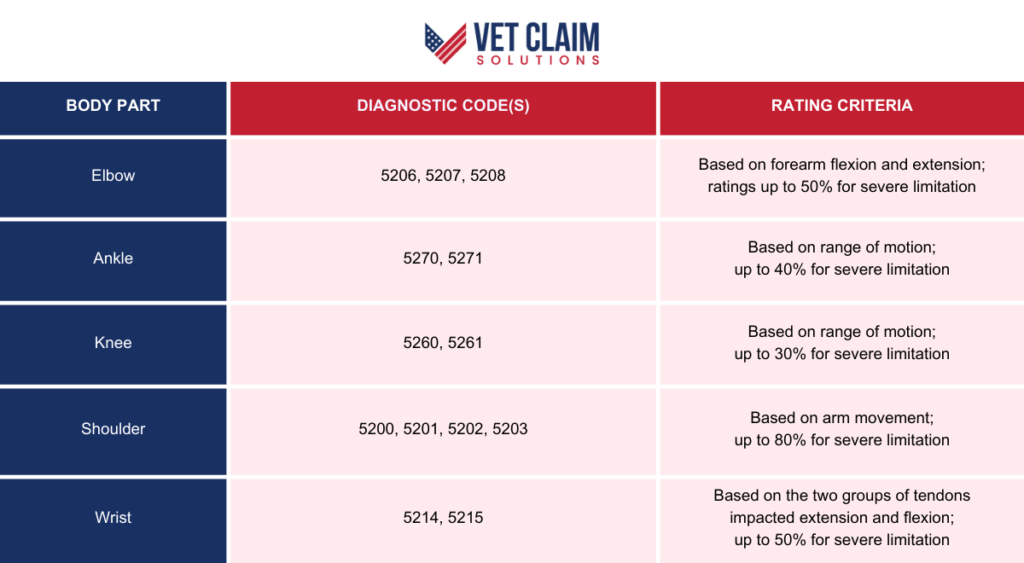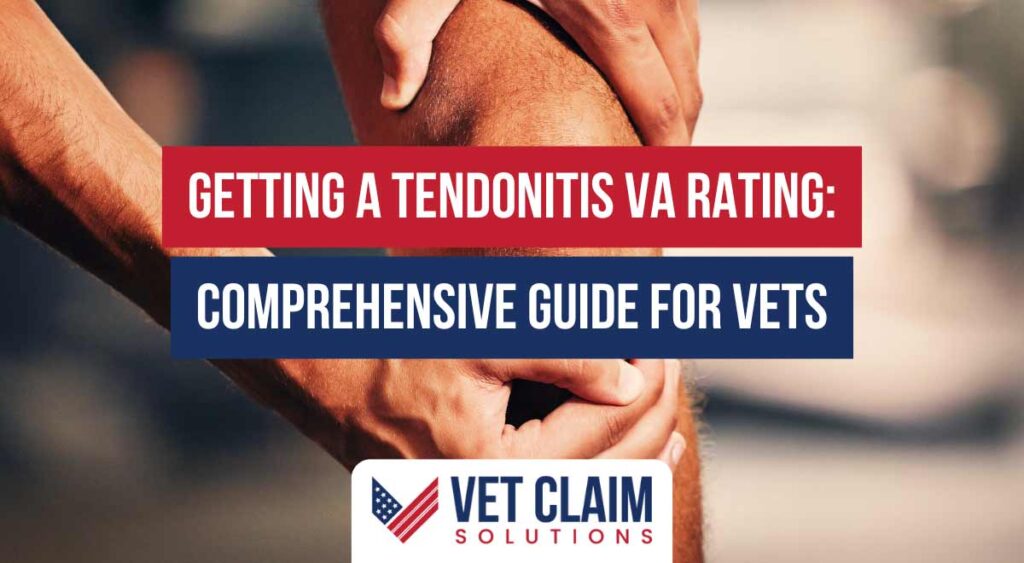If you’re a veteran dealing with persistent joint pain, you might be wondering if it’s tendonitis and, how it affects getting a Tendonitis VA rating. It’s a common question, and you might feel alone since it’s not easily discussed. This is especially true since many don’t fully grasp the physical demands of military life.
You’ll learn how the VA views tendonitis, how it connects to your service, and what it can mean for you. The goal is to give you clear insights into getting a Tendonitis VA rating.
The physical toll of military service is large. From training to active duty, your body endures a lot. This constant strain can lead to overuse injuries, including tendonitis, but is that service directly what contributed to your tendon pain now?
Understanding Tendonitis and Its Impact on Veterans
Tendonitis is the inflammation of the tough, fibrous tissues that connect your muscles to your bones. This often happens in areas like your knees, shoulders, or elbows. This inflammation leads to pain and tenderness around the affected joint, a common experience for many veterans.
Repetitive motions and physical stress are common during military service. The impact is even greater on the lower extremities, increasing the risk of developing this condition. The constant demands placed on service members may increase the possibility of having it, compared to people with less physically demanding jobs.
What Exactly is Tendonitis?
Tendonitis occurs with the swelling of a tendon. This causes pain and soreness, and is typically due to overuse or repeated injury.
Tendons enable joints to move, providing flexibility and protecting against muscle injury. However, repeated strain and impact can inflame the tendons and the surrounding area. A medical nexus is needed to link this to your time in service.

Signs You May Have Tendonitis
Have you felt a constant, dull ache in your shoulder, or a sharp pain in your knee that won’t quit? This could be a sign of tendonitis. It’s often a persistent discomfort localized around a specific joint.
Besides pain, other symptoms can have a huge effect on your daily life. Difficulty moving the joint and a grinding sensation are also common forms. You may also notice swelling or tenderness around the affected area, which should be examined by a doctor.
The Different Faces of Tendonitis
Tendonitis shows up in different ways across your body. Let’s discuss how you can spot it.
Shoulder tendonitis occurs when the rotator cuff and the biceps tendon severely swells. Symptoms include pain and reduced movement, often making it difficult to lift your arm to shoulder level. Elbow tendonitis causes pain on the outside of the elbow, which can extend into the forearm and wrist.
Knee tendonitis impacts the tendon connecting your kneecap to your shinbone. Ankle tendonitis affects the tendons surrounding the ankle joint, usually from repeated use, including the Achilles tendon. With wrist tendonitis, both groups of tendons in the wrist become inflamed, impacting both flexion and extension.
How Tendonitis is Connected to Military Service
Veterans often face physical challenges, which can make you wonder if tendonitis is common after service. Daily tasks from boot camp to deployment frequently involve activities like repeated heavy lifting or high-impact training. These demands on your body increase your chance of developing painful tendon swelling.
This work takes a toll, causing overuse. The VA recognizes this, and you may qualify for va disability.

Getting a Tendonitis VA Rating: Direct vs. Secondary Service Connection
You have a diagnosis, and some symptoms too. To get benefits, there has to be proof of service connection, but how does that connection work?
There are different paths to service connection for getting a Tendonitis VA rating. These include direct and secondary service connection. Let’s break that down.
Direct Service Connection Explained
Direct service connection means your military service directly caused your condition. Proving this requires three key components. To establish a direct service connection, here’s what you need:
- A current diagnosis of tendonitis.
- Evidence of an in-service event, injury, or illness.
- A medical nexus, or doctor’s statement, connecting your current diagnosis to the in-service event.
A Compensation & Pension (C&P) exam can help establish this link. However, getting an independent medical opinion can also be very beneficial, especially if the C&P exam result isn’t favorable.
Secondary Service Connection: A Different Path
Secondary service connection occurs when your tendonitis is caused by a condition already connected to your service. Many veterans experience secondary conditions resulting from an initial service-connected disability, like arthritis and diabetes.
To be eligible for a secondary connection, you must show your diagnosis. Then, prove with your records that it connects to something like diabetes or another service-connected condition.
Aggravation of Pre-existing Conditions
What about a pre-existing condition that has been affected by your service? This changes your life, right?
The VA also compensates for conditions made worse by active duty. This might happen if someone had tendonitis before service, but it worsened afterward. The connection then becomes service-related.
How the VA Rates Tendonitis for Disability
So, how does the VA determine the severity of your condition for compensation? Here’s what you can expect.
The VA rates your condition, typically using 38 CFR § 4.71a. A minimum 10 percent rating exists, but more serious conditions can warrant higher VA rates.
Decoding the VA’s Rating System for Tendonitis
The VA looks at how your motion is limited. The VA uses diagnostic code 5024 under the Musculoskeletal System schedule. Different joints have various rating methods; here is a table to make sense of the codes:

For the elbow, ratings consider the forearm. If flexion limited to 45 degrees, ratings may be as high as 50%. Diagnostic Code 5208 provides a 20 percent rating if forearm extension limited to 100 degrees.
For ankles, ratings use Diagnostic Codes 5270 or 5271, with 40% for limited motion. Knee tendonitis is evaluated under codes 5260 and 5261, potentially starting with 0%. Shoulder tendonitis uses codes 5200, 5201, 5202, or 5203, ranging from 10-80%.
The Bilateral Factor: Enhancing Your Rating
If both your knees have tendonitis, does that matter in getting your rating? Here’s the deal: if you’re impacted in areas on *both* sides of your body, such as both knees or both arms, the bilateral factor comes into play.
It makes sense, a condition in just one shoulder is tough. But imagine *both* shoulders – that is a much greater impact, so you are compensated differently.
Navigating the VA Claims Process for Tendonitis
Do you just deal with it, though, or get compensation? Knowing how to handle it makes all the difference in getting your disability claim approved.
Submitting a VA claim may seem complex, but you should know what is required. A clear strategy simplifies the process, including understanding forms, your communication, and the evidence.
Filing Your VA Claim: Steps and Strategies
First, provide documents including proof and a diagnosis. To begin the va claims, you’ll fill out the VA Form 21-526EZ.
The application process can involve additional reviews of how service impacts your life. Then, additional evidence is needed, including the C&P Exam.
Understanding the different roles is crucial for the VA and you. C&P Exams, for example, help prove your injury link, impacting whether it stems from military time, however the examiner isn’t prescribing medication.
Presenting a Strong Case: Evidence and Documentation
Getting additional medical reports will strengthen your case. Working with experts and Vet Claim Solutions also offers advantages; you have options.

Understanding Specific Tendonitis Conditions and Ratings
What are the details on individual tendonitis conditions that might have occurred, like your ankle or knee?
Ankle Tendonitis: Ratings and Considerations
Ankle tendonitis is rated under the VA’s diagnostic codes 5270 or 5271. These focus on how much your ankle’s motion is limited.
If there is abnormal stiffening (ankylosis), code 5270 applies. The ratings are 40% if your ankle is stuck in a severely bad position, a 30% rating in positions between 30 and 40 degrees, or 20% if less than 30 degrees.
With code 5271 you may get a rating for limited motion with plantar flexion. If your motion isn’t limited, then the VA will not give a disability rating for it.
Knee Tendonitis: A Closer Look at VA Evaluations
For diagnostic code 5260, you look at your motion. The rating could be:
- 30% if your knee flexion limited to 15 degrees.
- 20% if limited to 30 degrees.
- 10% if limited to 45 degrees.
This code is also applicable for rating patellar tendonitis.

Shoulder and Elbow Tendonitis: Understanding Your VA Rating
Your rating on tendonitis here differs. Elbow tendonitis va ratings depend on the forearm. The highest rating, under diagnostic code 5206, is 50%/40%, where flexion is limited to 45 degrees.
Your shoulder tendonitis va rating is based on arm movement, using diagnostic codes 5200, 5201, 5202, or 5203. Code 5200 addresses abnormal stiffness, with ratings of 50, 40, 30, or 20.
With diagnostic code 5201, focusing on arm issues, ratings range from 40% to 20, all based on your range and impacts. This depends on your ability to move the arm and its impact on daily life.
Wrist Tendonitis VA Ratings Explained
The VA classifies wrist tendonitis disability ratings based on two groups of tendons impacted. One issue, “extensors” exist. Another group, the front ones exist. Diagnostic codes 5214 or 5215 provide a minimum rating for tendonitis of 10%.
Depending on immobility, ratings could be as high as 50 percent. Getting help is a sign of strength.
Seeking a VA rating takes action, beginning with Vet Claim Solutions.
Conclusion
Getting a Tendonitis VA rating may look confusing at first. Having the right understanding, helps a lot. Taking that step requires knowledge of the requirements, including things like ankylosis and its impact.
With support, seeking the rating can have a major impact. Taking steps to improve your way of living comes from this.
With expert advice, we help many veterans like you deal with potentially debilitating impacts on your quality of life. We can provide you support in getting your combined rating for all of your conditions.


